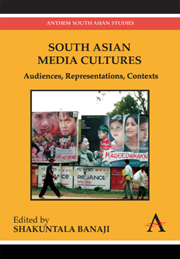Book contents
- Frontmatter
- Contents
- List of Illustrations
- 1 Introduction
- Part One Elaborating Audiences: Meaning, Use and Social Context
- Part Two Telling Texts: Media Discourse, Identity and Politics
- Part Three Alternative Producers: The Articulation of (New) Media, Politics and Civic Participation
- List of Contributors
1 - Introduction
Published online by Cambridge University Press: 05 March 2012
- Frontmatter
- Contents
- List of Illustrations
- 1 Introduction
- Part One Elaborating Audiences: Meaning, Use and Social Context
- Part Two Telling Texts: Media Discourse, Identity and Politics
- Part Three Alternative Producers: The Articulation of (New) Media, Politics and Civic Participation
- List of Contributors
Summary
South Asia through the Lens of Totalising Events
Throughout this volume ‘media cultures’ refers to the complex interactions between particular audiences, their practices of meaning-making and use, and specific texts, representations, formats or media. It also refers to the interplay of politics, history and finance in the relationships between media producers and texts, ideologies and social contexts. The chapters collected here present a wide range of media cultures and associated cultural practices from across South Asia. At the same time they explain those cultures and practices through a set of historical, political and theoretical engagements that share many common elements. This might be, for instance, in relation to violence and peace, ethnic divisions and state responses or conflicts between supposed tradition and erstwhile modernity. Or it may be in relation to pleasure and learning, autonomy, morality and resistance on the part of marginalised peoples or highly controlled groups. All of these have been explored by the authors in their research, and practice, in the areas of media audiences, texts and contexts in South Asia. Before treading new ground, however, it is worth asking why the kind of approach taken in this volume is so necessary, and why now.
Several cohorts of university students in London, listing what came immediately to mind in relation to the five best known countries in the South Asian region, almost uniformly linked India to words such as ‘vast’, ‘amazing’, ‘spiritual’, ‘Bollywood’, ‘non-violence’, ‘poverty’, ‘IT/call centres’, ‘large democracy’ and ‘beautiful’, Pakistan to the phrases ‘terrorism’, ‘Islam’ and ‘near Afghanistan’, Sri Lanka to ‘war’ and ‘honeymoons’, Nepal to ‘Mount Everest’ and Bangladesh to a single phrase: ‘always flooding’.
- Type
- Chapter
- Information
- South Asian Media CulturesAudiences, Representations, Contexts, pp. 1 - 26Publisher: Anthem PressPrint publication year: 2010



